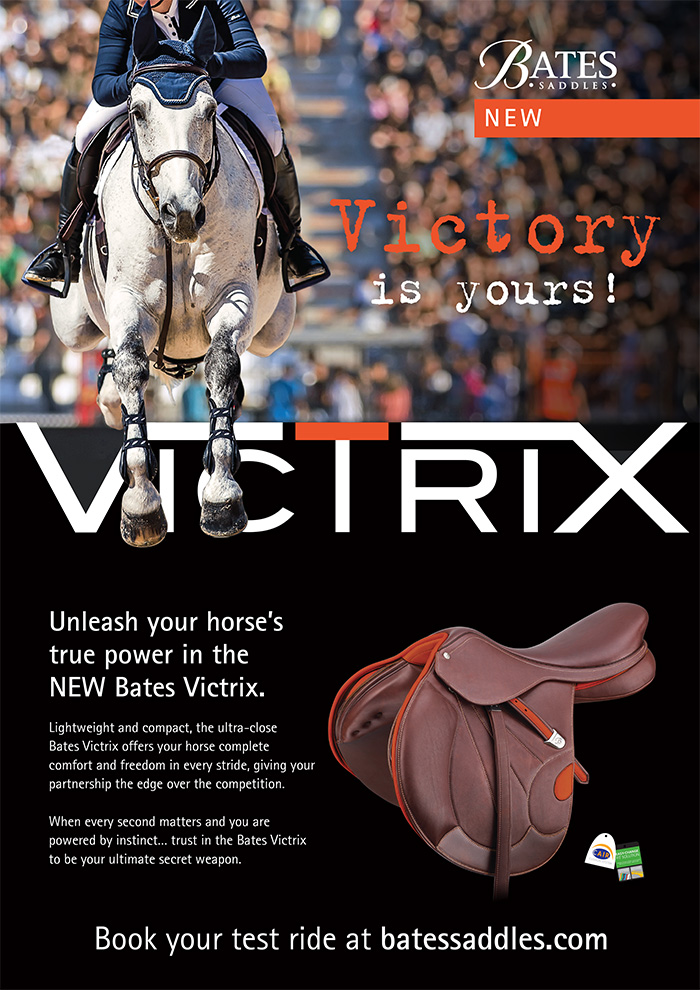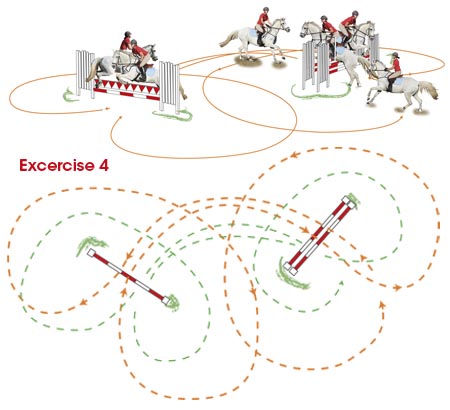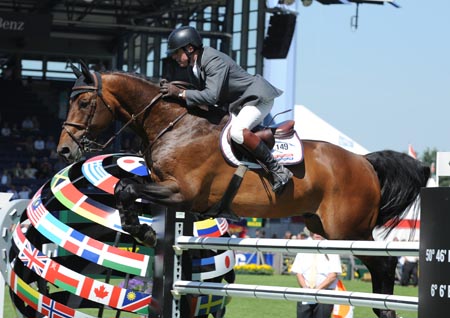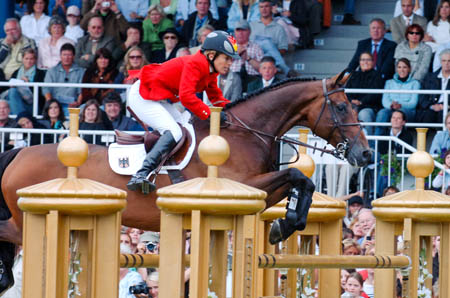Here’s another lesson from Colleen Brook, with Liz demonstrating, – you don’t need a lot of equipment, enough for two jumps – a vertical and an oxer. Let Colleen tell you how…
Liz Koob and Lady’s First are back with a gymnastic to improve our jumping basics.
The exercise was very simple, but really gave most of the basics that showjumpers need, a workout. It involved an oxer and an upright, set on a curving line.
The plan there was to practise changing your line, add a stride, then go more direct and take a stride out, so that you learn about playing with the distance, and then you go around the fences, you have time to breathe and relax and decide how you are going to get it done. You can have centre to centre, or just a shallow bend one way or the other, to add a stride. It was a true five-stride distance, then we just shaved it, or opened it up, as the case may be. It’s all variations on a theme. It’s surprising that riders who are not so confident about getting their horses back, when they bow the line out a little, thinking about getting their horse to come back – they do quite a good job of it. Vary it – come around, up your pace and go forward. You can do that ad infinitum with any horse, the jumps don’t have to be big at all, it is just a matter of having a plan and executing it.
It’s also probably a good one for the confidence for both the rider and the horse.
You start off getting it done and then you start to add a degree of difficulty as you start counting the strides, and then, changing the strides. It is a very useful exercise, I use it in my clinics… It’s probably another of George Morris’ exercises, he manages to get a lot out of every exercise. I don’t know where he gets all the different exercises from, but he keeps coming up with them.
What is the requirement when you ride a course? Well you have to be able to turn, you have to be able to bow the line a bit, that’s what it is all about.
story continues below the advertisement
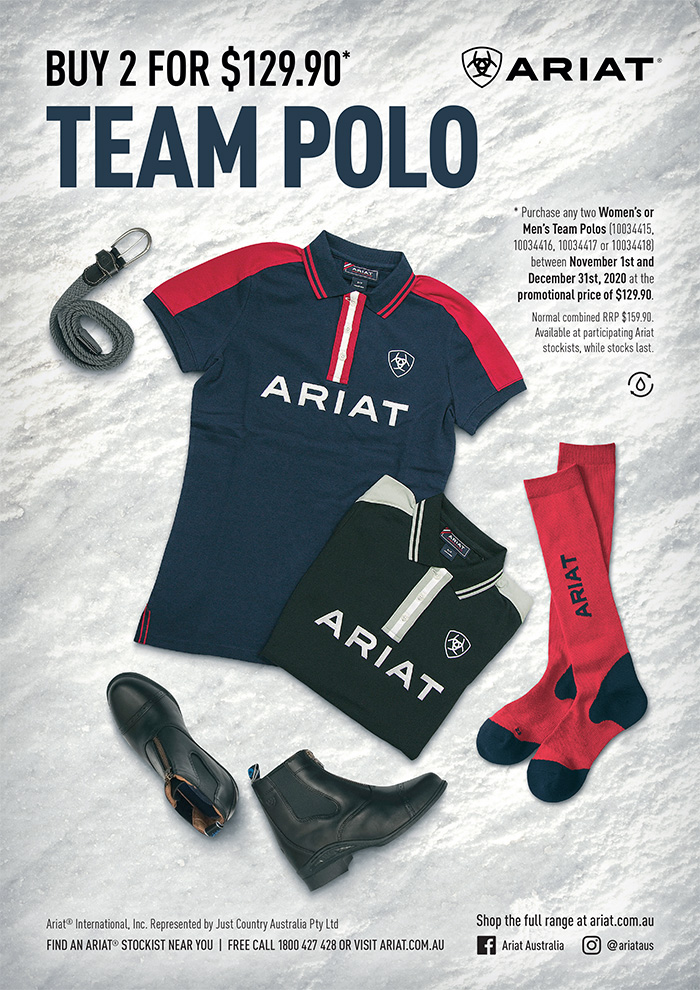
The Gymnastic for carefulness
Carefulness comes from the horse using its natural self-preservation combined with its trust in you, to get the job done and get over the fence without a fault. When you have a horse that is a puller in your clinic, it’s the rider who is always holding on to the horse, and it is a hell of a job to get people to let go. It’s not in our nature. We can’t let go. But as soon as you let go, and instead of concentrating on the horse’s head, you focus on the back end of the horse, the horse starts to breathe, and starts to think. Whenever the rider is busy doing something upstairs, then the horse stops thinking for itself. When you watch someone like Marcus Ehning ride, he just hacks around like he’s going for a ride round the block, I don’t think I’ve seen his horses in a sweat. They just canter around, and they don’t look fast and he makes it easy for the horse.
Making it easy – John Whitaker
One of George Morris’ favourite sayings is ‘John Whitaker makes it easy for the horse’ and he is the same as Marcus Ehning – it doesn’t look like he is doing anything, but the mind is going because you can’t sit there and be empty headed.
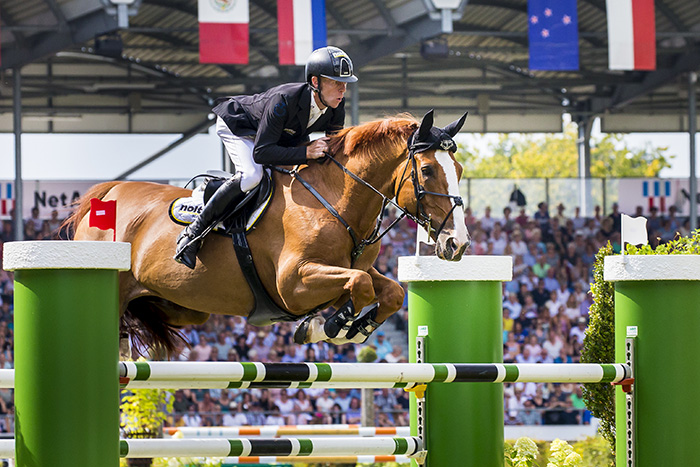
Marcus Ehning – it doesn’t look like he’s doing anything
For the self-preservation part, gymnastics usually do the job there. You try to make the distances not too extreme because if you do, you will end up scaring the horse. There are a million and one gymnastics written down, any book you pick up will have them and as long as it has the goal you are after, it should work. You can have trotting gymnastics, cantering gymnastics… there are gymnastics for increasing strides, gymnastics for decreasing strides. I think it was Michel Robert who wrote – you increase strides for inexperienced horses, you decrease strides for experienced ones.
So a one, two, three – or a three, two, one. Mix it up. If you are consistent with the gymnastics, that teaches the horse to be careful. Your job is the pace coming in, stay balanced and in the middle, stay out of their way and let them get on with it.
story continues below the advertisement
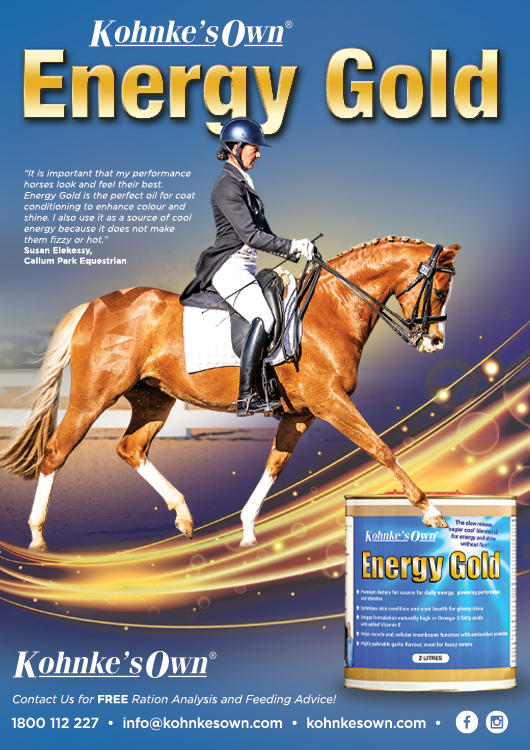
Bounces are great, but it takes a lot of gear to build a bounce, gymnastics in general require a lot of gear – and most people don’t have lots of gear. I try to have one gymnastic line that I can use as a trot or a canter exercise. Rushing horses, we have all had them – I like to use poles on the ground between the jumps or bounces, bounces on a circle are good too, and the rider must stay forward. If you can train the rider to stay calm and not grab and get anxious, then most times, the horse will slow down. It usually takes one session to fix the horse, and about six to fix the rider. In a clinic, I can usually see a change in the horse, but changing the rider takes a lot longer. The horse says ‘thank you very much I can do it easier that way’. If you are swinging off its head, kicking and pulling, unbalanced in the turn – how are you going to get to the jump? Not very well, and so they knock it down, and then the rider blames the horse. If you can do a good job for the horse, get it to the jump and say ‘there it is, there you go, do your best’, nine times out of ten, they can jump the fence. Our equine friends are not always the athletes we dream of. There are horse who are slow thinkers and then tense horses who knock down fences because they don’t give themselves time to jump.
Albert Voorn said many times, ‘We must take the leaning and hauling out of our riding’.
Shutterfly – a fast thinker
The higher you wish to compete, then a slower thinking horse is not the best choice, you get a horse like Shutterfly, who is obviously a very fast thinker. The trouble is there are not many riders who would suit that horse. Everyone ends up with a horse that they kind of feel good on, not too fast, not too slow. They go from the very slow thinkers who have to knock down a rail or two, before they get their legs out of the way, to the ones that are so careful that they knock it down because they are so tense. I say to riders, you have to do as good a job as you can with this horse – give it your best shot. If that doesn’t work out, then you can consider changing something, as George Morris said, ‘don’t ever think you are better than your horse’. I laughed when I heard George say that. Instead of blaming your horse, think about giving it the best ride you can, and then see what happens – you might be surprised.
I must say that I was impressed with the way the eventers jumped the double of narrow brushes on a very acute angle one stride apart in the World Cup round at SIEC. I thought you had to jump it, do a turn and jump it the other way – they went straight through and most of them did it well. I watched them very closely, and what the eventers do very well is set the horses up, say ‘there it is, off you go’ and most of those horses just pricked their ears and they went straight through. That was great, I loved watching that, how the horses read it so quickly, and bingo. I think a few showjumpers could learn from watching that…
Did you miss Colleen’s first set of exercises? Here they are…
